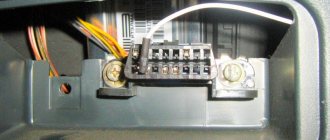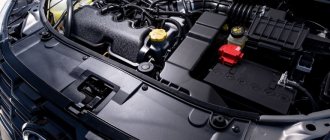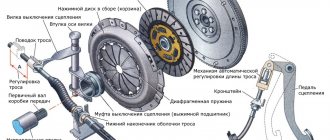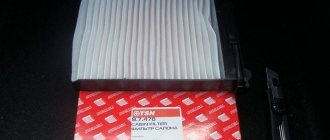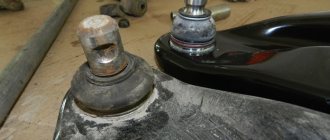According to reviews, the problem with floating engine speeds is familiar to many Lada Largus owners. This is especially true in winter, when the car has difficulty starting when cold (starting the engine is difficult in the morning). In such situations, floating speeds only make the situation worse. The tachometer needle may jump chaotically from 1000 to 1500 rpm or not reach the “warm-up” level at all, staying below the required idle speed values. Experts do not recommend self-diagnosis of the car. If the cause of the problem is unknown, it is better to contact a service station.
Car engine modifications and their features
The reasons why the speed may fluctuate on Largus are due to differences in the technical characteristics of the engines. Depending on the configuration, an 8- or 16-valve engine is installed.
8-valve K7M 800
This engine model was borrowed from Renault Logan and Sandero. Such motors have been installed on Largus since 2010. The unit complies with the Euro-4 standard, its power is 83 hp. With. Among the disadvantages:
- floating idle speed;
- high fuel consumption;
- lack of hydraulic compensators in the valve mechanism - the gaps need to be adjusted every 30,000 km;
- the need to replace the timing belt every 60,000 km - a broken belt will inevitably lead to bending of the valves;
- unreliability of crankshaft oil seals;
- vibration and increased noise during operation of the power unit.
The 8-valve engine is too weak for Largus. Among the advantages are the unpretentiousness of the engine and its inexpensive maintenance.
16-valve K4M
This engine is used only in the top modifications of Largus in the “Lux” configuration. Engine power is 106 hp. s, but it still requires improvements. It differs from the previous unit:
- absence of vibration and almost complete absence of noise;
- low fuel consumption.
The disadvantage of the 16-valve engine can be considered its complex design, which leads to the high cost of the car. The engine life is about 450,000 km, but servicing the unit is more expensive. The main thing is not to use it often under increased loads and undergo maintenance on time.
Loss of traction
Dear Forum members, good day!
I need your help. Maybe someone has encountered this problem. After the 3rd TO with the officials, traction began to disappear after 2 to 2.5 thousand revolutions (for a short time), then the check light came on and failures in traction became more frequent. I went to the officials again, did diagnostics, reset the error and said that the oxygen sensor and bad fuel. After a second visit, there were four gas stations (Gazprom), the situation worsened (I don’t think it was the fuel). The dip interval has increased from 2 to 3.5 in all gears (now I try to shift until 2 thousand). At idle, the revolutions began to jump from 200 to 1700 (for a short time). It’s impossible to get going, you have to wait for the jumps to disappear. I removed the terminal (repeatedly), the check goes out, but after 17-20 minutes the revolutions begin to float and everything repeats again. After 2 thousand, only re-gas helps (let it go and add it, but very carefully). Help! After the 2nd maintenance I changed the official because... where it was originally serviced, it ceased to be an official. Sincerely! New message added 09/21/2017 at 20:20:16 : Or tell me where and where to look
After the maintenance, the pipe to the air filter was half put on. The top was on, the bottom was not ((((.Sad OD. Thanks for the link!
New message added 09/21/2017 at 21:09:35 : All problems start after warming up
| kyshtym: |
| At idle the revs began to jump from 200 to 1700 |
The revolutions cannot drop to such a minimum because the starting speed of the internal combustion engine is 500
New message added 09/21/2017 at 21:39:33:
| kyshtym: |
| reset the error |
Is it possible to voice the error code?
The internal combustion engine operates normally until it warms up completely and starts moving, and even after driving it does not start immediately. Today I cooled it down for 8 hours, warmed it up to two degrees and drove slowly, rode for about forty minutes, no dips or jumps in revolutions. I tried different driving styles, both sharp accelerations and smooth ones, everything was fine. Although 18 hours earlier, after 300 km of the highway and entering I wanted to call a tow truck in the city, it was very sad (everyone is honking and screaming
New message added 09/21/2017 at 21:46:20 : Maybe I'm not explaining correctly?
A new message was added 09/21/2017 at 21:47:53 : I will only be able to find out the error code tomorrow; during diagnostics, they did not allow me to approach the master and the PC. It’s not a fact that they will tell the truth.
Somehow you can see the error code on the instrument panel? If you can provide a link) I’m not too lazy to look for it, I’ve just been googling for the second day and only then did they begin to answer adequately! Thank you!
New message added 09/21/2017 at 22:01:32 : V. Pavel , Thanks for the advice. I'll try tomorrow. I’ll buy it and run it on the stand
Source
Causes and methods of eliminating difficult engine starting
To successfully start the engine, the fuel mixture and a spark from the spark plugs must simultaneously appear in its cylinders.
The engine cannot be started if one or more elements are faulty. This happens, for example, when the starter does not spin the crankshaft.
If floating idle speeds have become too annoying, and it is no longer useful to turn the engine with the starter, it’s time to understand the causes of the malfunctions that have arisen. The table shows the most common reasons why the Lada Largus engine speed fluctuates and it may not start.
| Cause | Diagnosis and manifestations | Remedy |
| There is no gasoline in the tank. | On the instrument panel the fuel level arrow is at zero. | Fill with gasoline. |
| Low battery charge. | A characteristic crackling sound when trying to start. When checking the voltage it shows less than 12V. | Charge the battery. |
| Loose contact of battery terminals or their oxidation. | Crackling sound from under the hood. Low voltage on-board network. | Clean the terminals and fit them onto the battery terminals as tightly as possible. |
| There are no connections between the electrical circuits of the power supply and control systems | Checking the reliability of the connection of the wire blocks. | Connect the connectors tightly. |
| The rotation of the crankshaft is difficult (scuffing of the piston group, liners, deformation of the shaft, jammed water pump, generator). | Slow rotation of the crankshaft, extraneous noise when starting and running the engine. | Replacement of failed parts. |
| Problems with the ignition system. | Netiskra. | Check all elements and parts of the ignition system, replace if necessary. |
| High voltage wires are installed out of order or disconnected. | Inspection. | Install in the correct sequence and replace if necessary. |
| Broken or worn timing belt. | Visual inspection. | Replacing the timing belt. |
| The valve timing is disrupted. | Inspect the location of the crankshaft and camshaft marks. | Set the phases according to the marks. |
| Malfunctions in the electronic engine control unit (ECU): crankshaft position sensors, coolant temperature sensors, phase sensors. | Find out whether power is supplied to the ECU, whether there is an open circuit, check the serviceability of the sensors. | If necessary, change the software of the control unit or replace the ECU, as well as the sensors. |
| The IAC (idle air regulator) has failed. | Check the IAC (if the engine starts only with the gas pedal pressed, and stalls when it is released). | Replace the regulator. |
| Control system fuse or relay has blown. | Checking the relay and fuse. | After eliminating the cause of the blown fuses, replace them. |
| The fuel pump is faulty, the fuel pump relay fuse has blown. | After turning the ignition key, there is no characteristic sound of the pump in the gas tank when fuel begins to flow into the ramp. Check the fuse, apply voltage directly from the battery. | Replace faulty parts. |
| Fuel filter clogged, water freezing in the fuel line. | Measure the pressure in the fuel system. | Replace the fuel filter and fuel line parts. |
| Low pressure in the fuel rail. | Check the pressure, fuel pump filter and fuel line for damage. | Replace the filter or fuel pump, fuel pressure regulator. |
| Faulty injectors. | Check the functionality of the injectors. | Replace faulty parts. |
| Air in the intake system. | Inspect the intake parts for air leaks, check the vacuum brake booster. | Eliminate air leaks, replace the faulty brake booster. |
Regular and timely maintenance of the car will minimize or completely eliminate possible problems with starting the Lada Largus engine.
You should not randomly change all the parts without first checking their functionality. Comprehensive diagnostics are necessary, since there can be several sources of malfunction at once. Modern cars of the VAZ family are equipped with the same type of engines. For this reason, the solution to the problem will be virtually the same for different cars.
“Sores” that await every Lada Largus owner
Lada Largus is a popular car that has European roots and a French engine. For the first time, when this car appeared on the modern market, many were skeptical about it. However, high reliability characteristics and performance indicators have led many car enthusiasts to purchase this modern car. Despite the wide range of advantages, the car is still not insured against malfunctions, like any vehicle. Experts, having conducted various statistical and analytical studies, have identified the most common faults of the Lada Largus, which are discussed below.
Most problems can be fixed by yourself
Basic faults
It is important to note that highly qualified service center professionals claim that most Lada Largus car owners do not undergo the necessary diagnostic examination of the car after a certain mileage of operation. This leads to failure of various units and failure of the vehicle to move at all. Therefore, in order to prevent the occurrence of various malfunctions, it is recommended to undergo vehicle maintenance in accordance with operating conditions. Only in this way can the occurrence of the most common faults be minimized.
Malfunctions of the LADA Largus car concern various systems and components, but experts consider the following to be the most common:
Engine malfunctions
As you know, the car’s engine was made by a French company, but many car owners noticed that the unit does not tolerate high levels of lubricant. That is why, for optimal engine operation, it is recommended to pay close attention to the oil level. Checking this criterion is extremely simple: just look at the mark located on the dipstick. If there is an excess of lubricant, the oil seals fail, as a result of which they must be replaced in a short time due to the fact that the wear of the power unit increases. Owners of Lada Largus recommend that the oil level not exceed the upper mark on the dipstick. It's better to have it a little less.
The Renault engine is reliable
"Floating" speed
Various problems are repeatedly caused by floating speed that occurs when the car is idling. Often such a malfunction is clearly visible when downshifting or switching to neutral. To solve this problem, it is enough to replace the o-rings with high-quality analogues. Thus, you can quickly and permanently get rid of floating speed when the engine is cold.
This is what “floating” revolutions look like
“Fogy” power steering
The traditional weak point of this vehicle. If such a malfunction occurs, it is necessary to replace the sensor. In this case, it is important to use original spare parts from the manufacturer. Service center experts also recommend replacing the throttle cables with original spare parts. Otherwise, it will not be possible to avoid any problems with the car.
Air conditioner leak
This is the most common problem that almost all Lada Largus owners face. This is due to poor quality assembly, since after a diagnostic inspection of the vehicle it was discovered that the holes in the body and the drain valve do not match. Therefore, only qualified and experienced specialists can solve such a problem. Often, service center experts replace bolts and special fasteners in order to save the owner from air conditioner leaks.
How to fix a freon leak
Driver's seat malfunction
More than 50% of LADA Largus car owners are faced with a problem when, after a very short period of using the car, the back of the seat changes its position on its own. In this case, experienced specialists recommend replacing the specialized adjustment spring with a better one. Otherwise, if the problem associated with the position of the chair is not eliminated, then it is necessary to repair the mechanism or even replace it completely.
Repair or replace?
Despite such a wide range of different malfunctions of the LADA Largus, it still does not lose its popularity. However, it is important to note that there are also a number of faults related to the gearbox, suspension and braking system.
How to extend the life of a car
In order to avoid various malfunctions associated with the braking system, suspension and gearbox, it is important to listen to the advice of experienced users and competent professionals:
- Avoid getting liquid, dust and dirt inside the CV joint boot.
- In order to get the most out of your gearbox, it is necessary to periodically perform a preventive inspection.
- Carry out diagnostics of the brake system caliper and be sure to use only high-quality lubricants. This way, you can reduce the likelihood of problems related to the pads and brake discs.
- It is recommended to periodically remove, clean and lubricate brake discs and pads.
- It is not recommended to overload the car, as in this case the rear silent blocks may fail.
- The muffler can only be replaced using specialized tools or an angle grinder. This is due to the fact that the muffler is non-separable.
- Factory components in the form of wipers must be replaced with higher quality ones.
Advice from professionals
It is worth noting that service center experts recommend that Lada Largus car owners install windshield wipers that have a longer driver blade than the passenger blade. This way you can clean your windshield as much as possible.
Despite the wide range of various malfunctions and “sores” of the car, the Lada Largus is still a family vehicle. True, it is not suitable for transporting bags of cement or other heavy loads, which can lead to various malfunctions in a short time.
Take care of your car - perform diagnostics in a timely manner, based on operating conditions.
Did you like the article? Share with friends:
Largus motor k4m misfires
15 hours ago, danis11 said:
autoelectrik61 if you can't hear any skipping, maybe the knock sensor is faulty?
By the way, I didn’t check it) Thanks
15 hours ago, sapr said:
at XX at 600 rpm in 1 second the HF makes 10 revolutions. And will you see one gap every 1 second in CSS? Do not make me laugh
Haven't you ever seen script gaps? you can see how the cylinder falls out periodically
Here
The idea behind this script is simple, like all ingenious things, and is as follows. After passing through TDC compression, as a result of ignition of the mixture, the piston and, accordingly, the crankshaft receive acceleration. This acceleration clearly characterizes the efficiency with which the cylinder worked. Accordingly, we can introduce a certain conditional concept of efficiency and display it graphically as a point:
Let us once again pay attention to the fact that we are talking about conditional efficiency; evaluate it in percentages, kilowatts, horsepower, etc. it is forbidden. It is measured by the acceleration of the crankshaft after ignition of the mixture, using the DPKV signal or some other rotation sensor, but we'll talk about that later.
So, a graph is drawn up of the operating efficiency of each cylinder, on which each point is an instantaneous efficiency, that is, a characteristic of how a given cylinder worked at a given moment. The graph is a kind of broken line.
If the cylinder worked normally at the time of measurement, then the corresponding point on the graph will be located above the zero level, otherwise the graph will be below this level. The number of graphs corresponds to the number of cylinders, and this makes it possible to evaluate the engine’s performance visually and draw important conclusions. The engine speed graph is displayed in gray; it is needed for ease of analysis.
Is not it?
2 hours ago, sapr said:
...Were there actually no passes?
If there are actually gaps, you cannot shift the control range... Gradually destroy the engine...
and what about long-term correction?
how to understand in fact? I wrote that in the current parameters they are, about 20 per minute for each cylinder.
does not lead to mistakes on the spot. It takes a long time to drive on the highway.
on-site corrections
added 1 minute later
2 hours ago, sergei726 said:
I had cars like this. All the same! Chaotic misfires with injectors turning off in the rpm range up to 2000. The cars also passed a cloud of diagnosticians, etc. Everything has been changed and checked! Solved: by reprogramming the author's tune with a modified MF range from 2700 rpm! It doesn’t count skips up to these revolutions and works great! Clients “pissed” all over the corners with joy and happiness! There were two cars with the same jamb. Exactly K4M with EMC 3120 16 valve and practically a jamb from the interior!
Sergey, if the malfunction is not detected, please write in a personal message how much the firmware will cost




